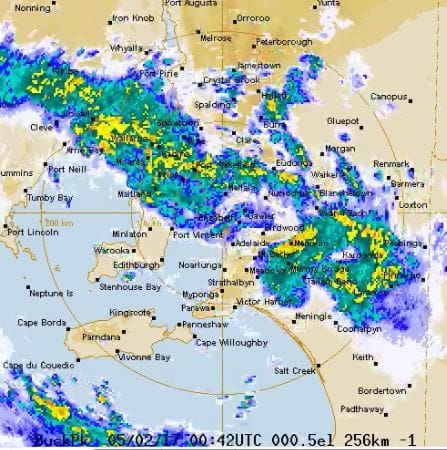This week Grain Central is looking at winter sowing intentions for growers from State to State. Today, South Australia is in the spotlight.
BARLEY and faba beans will take a back seat to canola, lentil and chickpea crops in South Australia this winter as growers look to capitalise on an unseasonally wet summer that has bolstered subsoil moisture levels heading into the winter cropping period.

Summer rains over South Australia, such as this band that crossed the state on February 5, have bolstered subsoil moisture levels in the lead up to winter crop planting. (Image: Bureau of Meteorology)
The flush of weeds over summer that has triggered a flurry of spraying activity across SA is indicative of how high subsoil moisture levels are in many parts of the state.
GRDC board member and grain grower in SA’s Lower North, Andrew Barr, said most regions of SA had had significant rain, including where he farms at Pinery 80 kilometres north of Adelaide.
“The most significant factor in our area is we have had 160 millimetres of summer rainfall which is hugely above average,” he said.
“Our whole farm has been sprayed twice for summer weeds and our moisture probes are showing that in the district there is between 60mm and 95mm of plant available water, depending on soil type.
“That soil moisture is stored at depth. From past experience, we will lose the top 30cm and keep the rest. That means the plants in our winter crop won’t see that until at least August, which is a good thing.
“The seasonal forecast is for the south-east of Australia to have way below average rain. Often we go into the growing season with zero to 20mm of plant available water, but to be in a position of having 60 to 95mm is a rare privilege.”
Mr Barr said low grain prices, particularly for cereals, would see farmers ease back on crops like wheat in favour of oilseeds and some potentially high-returning pulses.
“Barley and faba beans will take a fair belting based on price. They will bear the brunt,” he said.
“There is likely to be a big plant of canola. Lentils and chickpeas will be at least as strong as last year. We had an unbelievable year last year, with lentils in particular. There was a big area sown and for most farmers lentils were at the top end of their gross margins.”
On the Eyre Peninsula, Australian Grain Growers Co-operative chair and farmer, Andrew Polkinghorne, said growers were making their winter sowing plans based on solid, early-season subsoil moisture levels.
“There is plenty of summer spraying still happening, so that means there is moisture there,” he said.
“There will be a significant swing away from barley because of the price relative to everything else. There will be a swing into canola on the central and lower Eyre Peninsula. In the upper Eyre Peninsula they will concentrate on wheat. I think the lentil area will increase quite significantly, although it will be soil type related.”
SA grain farmers produced an estimated record-breaking 11.1-million-tonne harvest for the past season, worth a projected $2.2 billion at the farm gate. The state’s previous record crop was in 2010-11 at 10.3Mt.
Grain yields across most of the agricultural districts were well above average, but there was some downgrading of quality due to frost and hail damage in some areas.
Most districts reported lower wheat protein due to the high yields diluting protein and rain during harvest.
…………………….
See also Grain Central stories on:
Queensland sowing intentions: https://www.graincentral.com/cropping/winter-sowing-intentions-chickpeas-top-the-menu-for-queensland/
NSW sowing intentions: https://www.graincentral.com/cropping/winter-sowing-intentions-nsw-growers-hold-out-for-autumn-break/
Victoria and Tasmania sowing intentions: https://www.graincentral.com/cropping/winter-sowing-intentions-victorian-growers-turn-to-oilseeds-and-pulses/




HAVE YOUR SAY